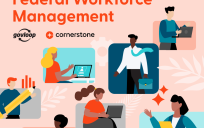It’s been a couple years since I was the Community Manager for GovLoop, but I continue to reflect on the problem of “information overload” for government employees, especially as it pertains to an internal system like an LMS, CMS or intranet.
We’ve had to address this problem with the GovLoop community as it’s grown over the past 7 years, now hosting thousands of blogs, research guides, infographics, and archived webinars. On top of that, GovLoop Academy has added more than 50 free online courses in the last year alone.
That’s a whole lot of learning goodness. But it can also be quite overwhelming.
And I’ll bet that’s exactly what has happened with your agency’s learning and content management systems
So what are your options for organizing an overwhelming amount of information?
Here are a few I’ll bet you’ve tried (and the likely results):
- APPROACH = Create better naming structures: You know the drill. Come up with a way to name the content and mandate that everyone uses that naming structure. (i.e. OwnerName_Document_Project_DRAFT_1997-01-15).
- RESULT = Within a few weeks, it became clear that people (a) didn’t get it, (b) refused to conform, and/or (c) simply forgot. It became impossible to find what anyone was looking for. So everyone gave up and elected to live with the mess they’d made.
- APPROACH = Organize it into folders. In this case, an agency elected to worry less about the naming structure, but chose to focus on where it lives. You developed a sophisticated architecture for sorting the content into neatly organized folders with intuitive naming conventions.
- RESULT = It worked for awhile, but people got frustrated after having to click through 7-8 folders to find the precise one with the exact version of the document they needed. So it didn’t stick and people created their own critical paths to content.
- APPROACH = Add metadata, such as “tags” to the information. One way that we tried to solve this problem on GovLoop was by adding tags to every piece of content. At first, we encouraged our end users to follow a specific taxonomy (see 1 above) and eventually limited them to a smaller number of broader, pre-determined topic areas.
- RESULT = This actually worked pretty well and set us up for what eventually became our Resources page (more in a minute on that), but the real challenge is that the limited number of topics didn’t cover all the kinds of content that our members wanted to blog about, so they force-tagged the content to make it fit.
Those are all reasonable and rationale approaches, each with a limitation, but I’d like to suggest four ways that have worked a bit better:
- Organize the content in a matrix format.
One way that we arranged our GovLoop content was to create a content map in a matrix format. First, we asked, “What are the most important and relevant topic areas to our community members?” Then we asked, “What are the types of content that we have produced (guides, infographics, online trainings, etc.)?” Based on those two questions, we created our Resources page: https://www.govloop.com/resources/ Click around that page a bit and you’ll see how quickly you can sift through a lot of content to narrow your results and find what is most relevant to you. - Make it visually appealing.
As you also see on that page, rather than relying on text alone (an Achilles heel of today’s learning and content management systems), we took the cover of our guides or an icon / image that represented the content in order to make the page more attractive. While there are still dozens of pieces of content in some search results, it’s much more interesting to browse the page in this format. We borrowed from these lessons in building our mentors module as well (see http://academy.govloop.com/mentors). Rather than having text only for the search process, both mentors and mentees have profiles with pictures that make it feel more like you’re interacting with real people (because you are! 🙂 ). - Create learning paths that connect related content.
Building on these results, also structured some of the content on GovLoop Academy into what we call “learning paths.” In order to support our guests in finding similar content and to encourage them to complete more lessons, we grouped 3-4 courses together into learning paths, such as Personal Growth, Engaging Citizens and Communities and Career Advancement. If someone finishes all of the courses in that learning path, they’ll earn a digital badge that’s displayed on their profile. - Empower a team of learning concierges.
Lastly, while technology can get you a long way, there’s often no substitute for having humans available to help in navigating an enormous amount of content. A couple months ago, I was speaking at an agency that designated certain staff members as “learning concierges” [link: http://www.c4lpt.co.uk/blog/2013/07/03/learning-concierge/] – people who dedicate a portion of their time to fielding and finding requests for information in the agency’s learning and content systems. When I was the community manager of GovLoop, I was happy to help anyone who inquired about finding a blog on a particular topic. And that’s what these people do for their colleagues who would likely waste a lot of time searching for something that a learning concierge can identify in minutes.
So that’s four ways I’d recommend that you consider when it comes to organizing the learning content at your agency.
If you happen to lack the technology or people power to implement my suggestions, please let me know. I’d welcome the chance to help you think through some alternatives, including working with me and my team!





Leave a Reply
You must be logged in to post a comment.